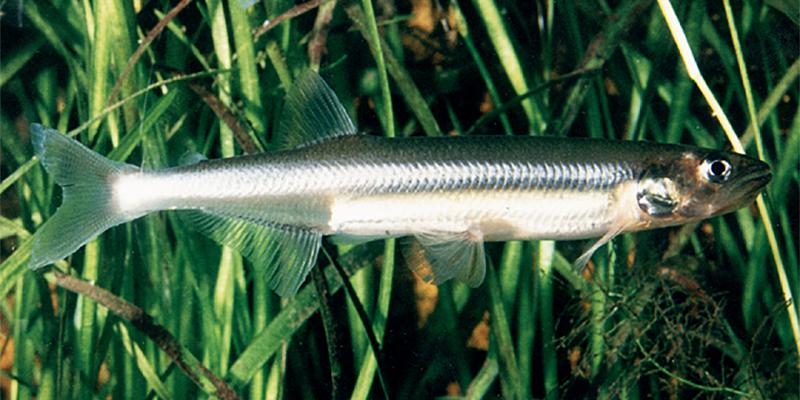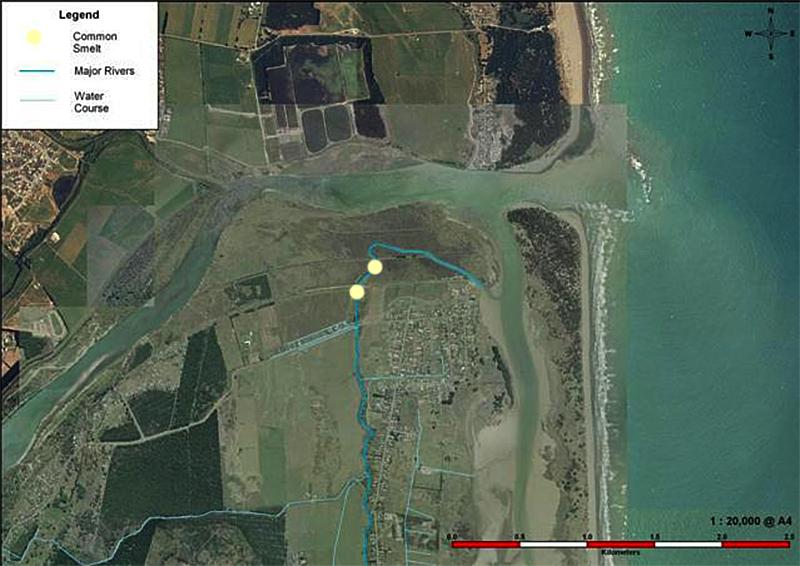Common Smelt
International Distribution South-Eastern Australia, New Caledonia, Chatham Islands
National Distribution in coastal waters around New Zealand
Distribution in the Styx River
The only records of common smelt are near the tidegates. They are known to form part of the whitebait catch (Hardy 1986) and were at least common in Brooklands Lagoon (Eldon & Kelly 1985). When the water is clear, shoals of these fish can be seen around the tidegates and feeding shoals would penetrate further upstream when the gates are open.
Fishery
The common smelt is sometimes regarded as a part of the whitebait catch, and is sometimes classified as one of the whitebait species, along with members of the galaxiid family and another smelt species, Stokell’s smelt. It is likely Maori caught and ate smelt, along with other whitebait, and had ingenious ways of catching these small fish (Hardy 1986).
Biology
Common smelt have virtually a marine lifecycle. Different physical differences (vertebral counts) have been reported in smelt from different habitats (McDowall 1990). It seems that smelt that go to sea have more vertebrae than smelt that reside in fresh water. Historically common smelt were deliberately introduced into many New Zealand lakes to serve as a forage fish for the introduced trout fishery.
Smelt are known to spawn on the sand banks of the lower reaches of rivers, and this is likely to happen in the meandering tidal area downstream of the tide gates. They go to sea for a short time and then an influx of juveniles enters Brooklands Lagoon in December and January (Eldon & Kelly 1985).
Common smelt feed on a wide range of invertebrates, although the young fish feed on tiny zooplankton (Boubee & Ward 1997). Chironomid (midge) larvae are likely to be common diet items smelt residing in the Styx River. A curious aspect of the common smelt is its odour. The fish has an odour exactly like cucumber. Research has indicated that the chemical which produces the odour in both the skin of common smelt and cucumbers is the same. The function of the chemical is unknown, but is also present in other related fish (McDowall et al. 1993). Smelt appear to be a delicate fish, and have been shown to be sensitive to stressors, including low levels of oxygen and ammonia (Richardson 1997; Richardson et al.2001). As such, the species has been suggested as an indicator fish for toxicants.
References
- Crossland, A. 2003. Ecological values and wildlife opportunities of the lower Heathcote Valley floodplain. Report for the Parks and Waterways Unit, Christchurch City Council.
- Boubee, J. A. T.; Ward, F. J. 1997: Mouth gape, food size, and diet of the common smelt Retropinna retropinna (Richardson) in the Waikato River system, North Island, New Zealand. New Zealand Journal of Marine and Freshwater Research 31: 117-154.
- Eldon, G. A.; Kelly, G. R. 1985. Fishes of the Waimakariri River estuary. New Zealand Ministry of Agriculture and Fisheries, Christchurch. Fisheries Environmental Report No. 56. 59 p.
- Hardy, C. J. 1986. Waimakarirri River and its whitebait fishery. Fisheries Research Division, Ministry of Agriculture and Fisheries, Christchurch. Fisheries Environmental Report No. 73. 68 p.
- McDowall, R. M. 1990: New Zealand Freshwater Fishes: A Natural History and Guide. Auckland, Heinemann Reed. 553 p.
- McDowall, R. M.; Clark, B. M.; Wright, G. J.; Northcote, T. G. 1993: Trans-2-cis-6-nonadienal: The Cause of Cucumber Odor in Osmerid and Retropinnid Smelts. Transactions of the American Fisheries Society 122: 144-147.
- Richardson, J. 1997: Acute ammonia toxicity for eight New Zealand indigenous freshwater species. New Zealand Journal of Marine and Freshwater Research 31: 185-190.
- Richardson, J.; Williams, E. K.; Hickey, C. W. 2001: Avoidance behaviour of freshwater fish and shrimp exposed to ammonia and low dissolved oxygen separately and in combination. New Zealand Journal of Marine and Freshwater Research 35: 625-633.



